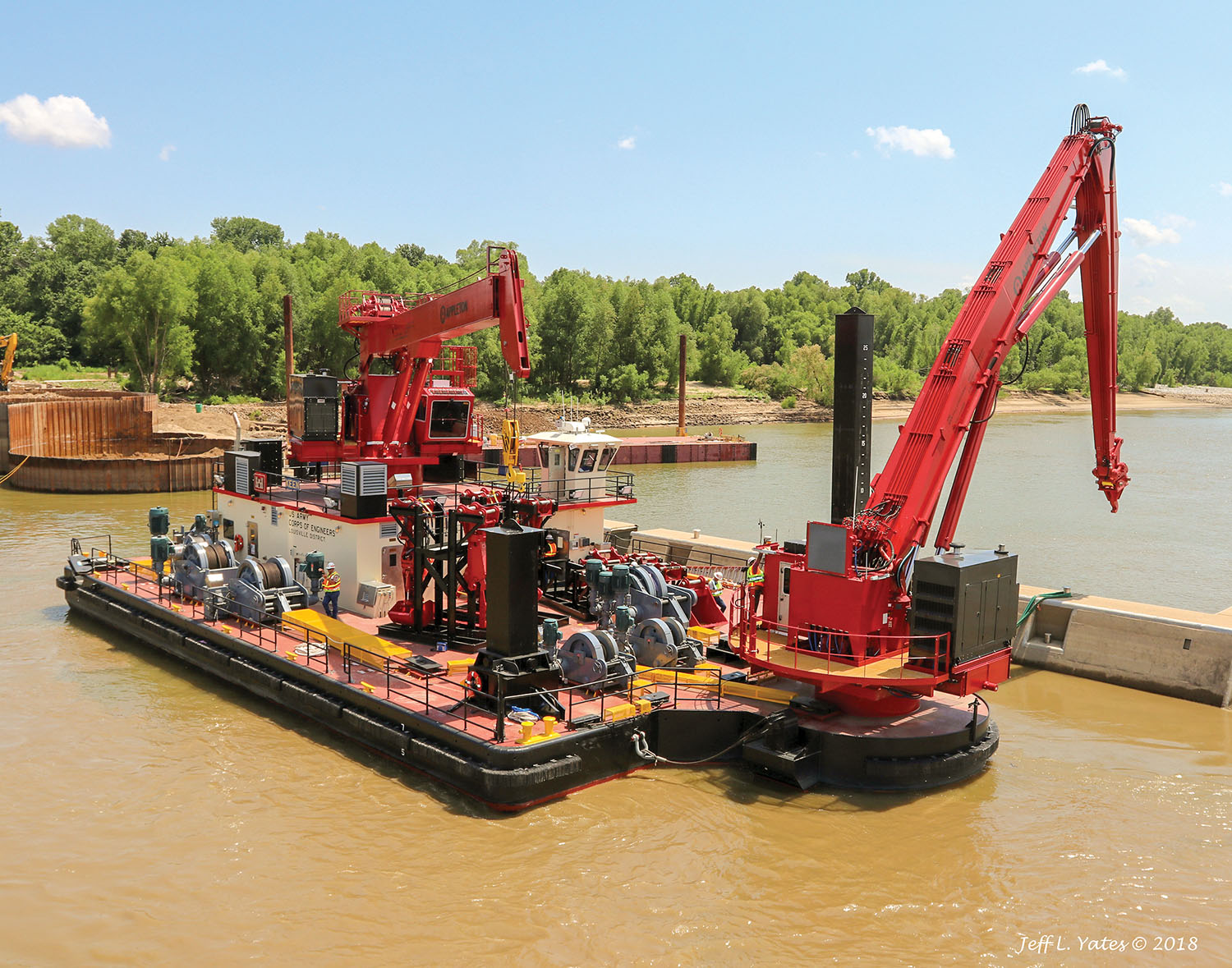The Olmsted Locks and Dam, dedicated August 30 nearly three full decades after Congress first authorized the project in November 1988, stretches more than half a mile across the Ohio River at Mile 964.4. Besides the two 110- by 1,200-foot locks at the project, Olmsted features five massive tainter gates, each measuring 110 feet wide, and a 1,400-foot navigable pass.
During higher river levels, tows will be able to bypass the locks, traveling instead through the navigable pass. During low water season, the U.S. Army Corps of Engineers will raise 140 wickets, each 10 feet wide, across the navigable pass in order to raise the pool above Olmsted enough to maintain navigation through the locks.
Raising and lowering the wickets will hinge on the other component of the Olmsted project that was dedicated August 30: the wicket lifter James M. Keen.
The wicket lifter Keen, a barge measuring 110 feet, 6 inches by 60 feet with a molded depth of 8 feet, 6 inches, is named for James M. Keen, who retired from the Olmsted project in 2012 after 39 years with the Corps. Keen was chief of contract administration for the Olmsted project and is credited with administering the $300 million fixed-price contract for the two locks and the $1.8 billion cost reimbursable contract for the dam. Keen died in 2016.
Conrad Shipyard in Morgan City, La., won the contract to build the barge for the Corps, with Power Dynamics Innovations LLC, located at the John C. Stennis Space Center in Hancock County, Miss., designing and manufacturing the winches and winch controls aboard the vessel. The cranes were supplied by Appleton Marine. Bristol Harbor Group of Bristol, R.I., designed the barge, working with the Corps’ Marine Design Center in Philadelphia, Pa. The Keen was delivered in February.
“We are proud to be a part of the Olmsted Locks and Dam Project, the largest and most expensive inland water navigation installation ever built in the United States,” said Conrad Senior Vice President Dan Conrad. “More than 90 million tons of material is shipped through the locks annually and [Olmsted] will speed traffic and ensure the efficient flow of commerce on the Ohio River.”
“This vessel is a testament to the extraordinary level of quality, craftsmanship, integrity and service that Conrad consistently delivers,” Conrad President and CEO Johnny Conrad said. “We appreciate the Corps’ continued confidence in our company and in the exceptional skills of our workforce.”
The wicket lifter Keen is an American Bureau of Shipping (ABS) classified Maltese Cross A-1 river service crane barge. The Keen is outfitted with two John Deere generators and an electronics switchboard from Gulf Coast Power. Appleton Marine supplied two cranes for the barge: a wicket lifter knuckle boom crane with a 65,000-pound capacity at 55 feet and 30,000-pound capacity at 77 feet, as well as an extendable boom maintenance crane.
Power Dynamics Innovations supplied a total of eight winches for the Keen: three spud winches each with 25,000-pound line pull, two positioning winches with 30,000-pound line pull, two anchor winches with 33,000-pound line pull, and the hoist winch for lifting the wickets. The hoist winch boasts a whopping 150,000-pound line pull.
The barge also features a Schoellhorn-Albrecht 10 hp. capstan with a 12,000-pound line pull, as well as a deck anti-icing, three-zone heating system from Electro Plastics.
New Technology And Equipment
Waylon Humphrey, deputy chief of operations for the Louisville Engineer District, which oversees the Olmsted Project, said Olmsted is similar to Locks and Dams 52 and 53, which it’s replacing, in that they all employ wicket dams, also called movable crest dams.
“You’re essentially standing up this temporary dam to get us through the low-water season,” Humphrey said.
One key difference between the old dams and the new one at Olmsted is that the Corps had to manipulate the wickets at 52 and 53 to adjust the flow during low water season.
“Here at Olmsted, after we raise those 140 wickets, we then have five tainter gates,” Humphrey said. “We can use those tainter gates to control the flow.”
That means at Olmsted, the wickets will either be all up or all down, with typically no manipulation of the wickets. A crew of 14—eight on the wicket lifter barge and six on the towboat assisting the lifter—will divide into two shifts, working from the Kentucky side to the Illinois side to lift the wickets. Humphrey said he estimates it will take between 24 and 36 hours to lift all the wickets during a normal season.
Looking at the wicket lifter Keen versus the two vessels it’s replacing, Humphrey said there are definite similarities in its task.
“But it’s obviously a lot bigger, a lot newer, and the controls are a lot fancier,” Humphrey said. “The old barges, which we call maneuver boats, have a steam-powered engine on them that drive a stern winch, then a steam crane on the front of it.”
The wicket lifters at 52 and 53 came online in 1949 and replaced the dams’ original 1929 wicket lifters.
At Olmsted, the wicket lifter Keen trades steam for diesel engines, but the power and technological advances go far beyond fuel.
First, the wicket lifter Keen has a pair of positioning winches tasked with holding the vessel steady as it lifts and lowers wickets across the dam. Both have 30,000-pound line pull capability and use 1-1/4-inch winch lines connected to anchor points on the Kentucky bank. The barges at 52 and 53 have only a single positioning winch with a 7/8-inch line. That boost winch and line strength is crucial to preventing the wicket lifter at Olmsted from being drawn around the dam and pushed downstream during operations.
“As we’re raising the wickets, we’re essentially choking down the river,” Humphrey explained. “Imagine sticking your thumb over the end of a water hose. At first it’s not that bad, but the farther and farther you go it starts accelerating the water because you’re reducing that cross-sectional area the water has to flow through.
“That wants to pull the vessel around the standing wickets we have, essentially to suck it through the hole we’re creating,” he said. “The smaller that hole gets, the stronger that force is. So we have these winch lines that go back to the bank, and that’s our safety line, essentially, that holds us to the shore.”
Complimenting the positioning winches is a new twin-screw, 2,000 hp., Z-drive towboat, which will assist the wicket lifter Keen by holding it against the dam and helping it move laterally across the channel. Humphrey said it’s the first Z-drive vessel in the Louisville District.
“It’s a perfect application for a Z-drive because we need to apply lateral thrust and forward thrust,” he said.
Perhaps the greatest advancement on the wicket lifter at Olmsted will involve its primary task: raising and lifting the wickets. GPS will allow the Keen’s crew to locate the center point of each wicket.
“Then we’ll use sonar that’s built into the boom tip to get a live feed of the boom tip under water and get the hook positioned into the catching bar that raises the wicket,” Humphrey said.
Then GPS will aid the crane operator in lifting and setting each wicket properly.
Humphrey said the wicket lifter crew will also have different tip attachments at their disposal—a water jetting nozzle, for example—to aid in removing silt or logs that would impede the raising or lowering of wickets. There is also automation features built into the positioning winches.
“It’s a 10-foot advancement mode,” said Carl Liberty, managing member of Power Dynamics Innovations. “If the operator wants to advance to the next wicket, he activates that system and the winches will automatically move the barge 10 feet out. Our capabilities in automation are really pretty heavy.”
Liberty added that the wicket lifter Keen features control stations at each winch, in addition to the master control console.
With the wicket lifter Keen officially coming online, the question turns to the near-70-year-old wicket lifters at 52 and 53. Humphrey said the Corps has initiated a process to dispose of the vessels, with their final fate to be determined.
“We’re surveying; we’re doing some research to see if we can find an interested party who would take them on and preserve that piece of history,” he said. “But at the end of the day, if we can’t find anyone, they’ll go through our normal equipment disposition process. If no one is interested, they’ll eventually be scrapped.”
Note: this story was updated September 17 to add Bristol Harbor Group’s role in designing the barge.



